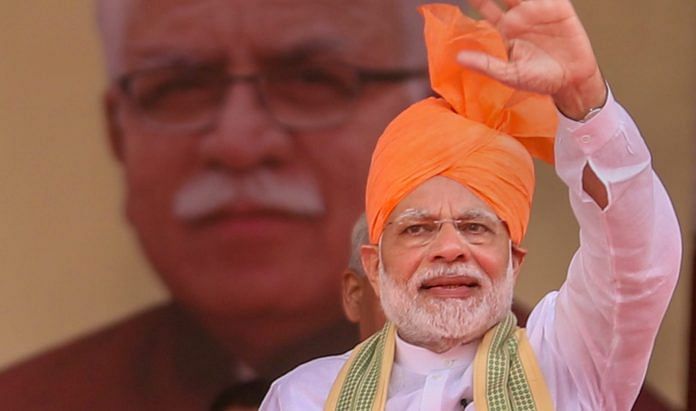Jats hold they key in states such as UP and Rajasthan, which will vote this year-end. BJP is also trying to assuage farmer anger in different parts of the country.
New Delhi: Elections in mind, Prime Minister Narendra Modi Tuesday delivered a carefully composed speech to impress the Jat community while outlining his government’s pro-farmer and welfare initiatives at an event in Rohtak.
Modi unveiled a 64-ft tall statue of Sir Chhotu Ram, one of India’s most illustrious farmer leaders, in the presence of Union Steel Minister Chaudhary Birender Singh, the former’s grandson.
The move, however, was loaded with political symbolism and aimed at pandering to Haryana’s powerful Jat peasantry that accounts for almost 25 per cent of the state’s voter base, but which has so far largely stayed away from the BJP.
“It is my fortune that I have got the opportunity to unveil this grand statue of Deenbandhu Chaudhary Chhotu Ram — the voice of farmers, messiah of Jats and a great guide,” Modi said.
“Chaudhary Chhotu Ram was among social workers who played a very important role in building India,” he added.
“He was a powerful voice of the farmers, workers, the deprived and the oppressed. He stood up against divisive forces,” the PM said.
Also read: Behind Modi’s move to unveil Sir Chhotu Ram statue is Haryana’s angry Jat population
Why Jat vote is crucial
Haryana is due to face assembly polls next year. The state has 10 Lok Sabha seats as well. The Jat vote in the state has traditionally gone to the Indian National Lok Dal, founded by Chaudhary Devi Lal, or the Congress, when led by a Jat leader.
But it isn’t just Haryana. Jats also hold they key in states such as Rajasthan and Uttar Pradesh. Rajasthan, where Jats comprises around 15 per cent of the population, goes to polls this year-end.
The PM’s emphasis on reaching out to this community comes at a time when his party is facing a backlash from its traditional upper caste voter, who believes the BJP is pandering to the Dalits. The BJP has been looking at ways to expand its social base and maximise its outreach.
Larger political message
Modi, meanwhile, used the platform not just to appeal to the people of Haryana but also to send out a larger political message.
Talking about the rail coach factory in Sonepat, the PM said it would help the entire state and promote employment opportunities.
Specifically aiming to target the farming community — not just in Haryana but across the country — Modi listed his government’s pro-farmer announcements such as the Pradhan Mantri Annadata Aay Sanrakshan Abhiyaan (PM-AASHA) as well as the hike in minimum support prices for crops.
The BJP government at the Centre has attempted to project itself as pro-farmer since 2014, launching a slew of initiatives for the rural sector. Farmer anger in different parts of the country — witnessed most glaringly in violent protests in Mandsaur in Madhya Pradesh last year — have made the BJP edgy, making the party emphasise even more on reaching out to this community.
Also read: The real 2019 fight isn’t between Rahul Gandhi and Narendra Modi
Modi did not spare the opportunity to talk about his government’s flagship initiatives such as Jan Dhan Yojana and the latest Ayushman Bharat scheme, and said the latter’s first beneficiary was a “daughter from Haryana”.
No Modi speech in Haryana is quite complete without the mention of his Beti Bachao, Beti Padhao initiative and Tuesday was no different.
“Wherever he is, Chaudhary sahib would be very happy to see the success of Beti Bachao, Beti Padhao in Haryana. He had always objected to how the society thought of women,” Modi said.
“Now that Haryana’s daughters are making us proud on global platforms, we feel we are moving quickly towards fulfilling Chaudhary sahib‘s dreams,” he added.







Missing in this column is any mention of CM Manohar Lal Khattar, neither a Jat nor – strictly speaking – a Haryanvi.